WASHINGTON, DC, US — US Hard Red Winter (HRW) wheat exports are forecast to fall to their lowest level since the US Department of Agriculture (USDA) began tracking such data in 1973, according to a recent report from the Economic Research Service (ERS).
In its monthly Wheat Outlook Report, released on Sept. 14, the ERS projected HRW exports to decline to 155 million tonnes, revised downward by 10 million tonnes from its August projection.
“HRW supplies have seen a long-term downturn in US acreage as corn and soy have gained acreage in many locations,” the ERS said. “At the same time, international wheat competition has surged, resulting in exports of this class being less competitive on the global market.”
Historically, HRW has been the leading class of US wheat exports, but this marketing year it is forecast as the third largest behind Hard Red Spring (HRS) and White wheat. The report noted that HRS and White wheat production is down year-over-year due to lower yields, but drought has not affected those classes to the same extent has HRW.
All-wheat exports for the United States in 2023-24 are projected at 700 million bushels, unchanged from the previous monthly estimate.
The ERS said US wheat exports “continue to be priced uncompetitively on the global market, resulting in a slow pace of sales.” Total US export commitments as of Aug. 31 were at 7.9 million tonnes, down 21% from the same time a year ago.
The agency noted that because US HRW prices are elevated this year due to drought, wheat has been imported from the European Union at some US ports. According to ERS methodology, 75% of the imports from the EU are counted as HRS and 25% Soft Red Winter.
“However, market sources indicate that the imported wheat from Europe is functionally most similar to HRW,” the ERS said.
In June, it was reported that some US flour mills were importing EU wheat because it was cheaper to bring it across the Atlantic Ocean instead of from the US Great Plains.




